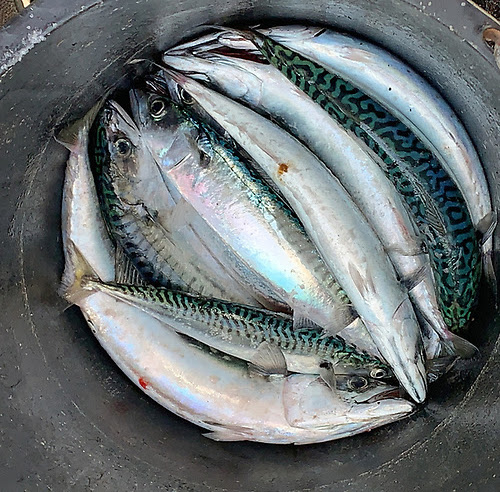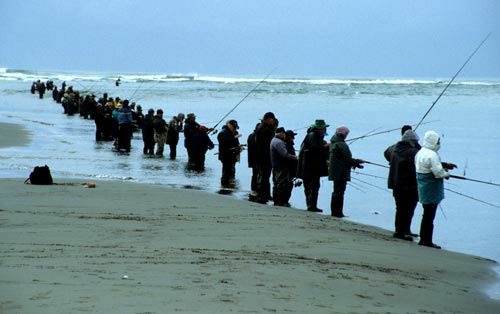When to Catch Mackerel In Scotland
Mackerel are one of the most popular and abundant species for the Scottish shore angler, great to eat and use for bait too. However, they aren’t around in huge numbers all year round so it’s important to time your trip right for the most chance of success. So when should you target Mackerel in Scotland?
So what time of year do we look to catch Mackerel in Scotland?
If you want to catch Mackerel, you have to time it right. Mackerel migrate to our shores to spawn in shallower water than they overwinter in and will often start to show up in boat anglers catches in mid to late spring (March-May). Then as the water begins to warm, and the winter species such as Cod move out to deeper areas making way for our favourite summer species, the Flounder and the Mackerel.
As we enter Summer time (June-August) our inshore waters will have warmed enough and the Mackerel will start to show up for shore anglers, usually small ’Joey’ Mackerel to start with in small shoals, gradually building up with better size fish and bigger numbers as the weeks go on. In the UK Mackerel will start to hit shore in the south first, gradually reaching more northerly parts are the water temps rise, so it can be useful to watch social media and the angling press to find out who’s been catching and were in the UK so you can assess how far they have spread up the country!
In recent years we have noticed more Mackerel being found by anglers in Autumn (September-November) but never in huge numbers – maybe a sign of the times or maybe there’s just more people out there fishing for them, but still worth a cast in the usual spots. As the temperatures drop off the vast majority of Mackerel will gather up into huge shoals and head out to sea for deeper water – although every year winter anglers will pick a few up in our deeper sea lochs, and a Christmas mackerel is not unheard of or even rare anymore!
What tackle do I need to catch Mackerel?
Mackerel fishing gear is quite simple, from the shore you will need a strong Spinning Rod that will cast a minimum of 30g for lure fishing, a fixed spool reel loaded with suitable mono (6-15lb) or braid (20-50lb), and some snap swivels for quickly changing lures over. Suitable lures should be sleek, silvery and of a long casting design, choose weights of lures in the upper range of the casting weight on your rod to help with distance, and often the cheaper lures are the best for Mackerel!
Start by casting as far as you can, and counting your lure down as deep as you dare, searching various depths until you find the familiar tap-tap-surge of a Mackerel on your hook! Fish every inch of the water in front of you - Mackerel are not always that far out and can often be found under your rod tip or even inside bigger harbours! Look out for action from the anglers either side of you as the Mackerel shoals move up and down the shore line feeding! If another angler is catching but you are not then watch them closely – it’s not always what you are fishing with but how they are fishing it that makes all the difference!
If you want to try jigging feather rigs you will need a strong Spinning rod casting 60g plus or a light Beach set up with a strong fixed spool reel or even a multiplier loaded with mono (15-30lb) or braid (40-80lb), some heavy snap swivels and leads in the upper weight range for your rod, as well as a few rigs – feather rigs and reflective tinsel rigs are hugely popular and effective. If you will be fishing from a boat, the same gear but with a 10-20lb class boat rod would suffice.
Fishing feather rigs is easy, if a little labour intensive – but catching multiple fish in one cast can fill your belly or your freezer fast! Simply cast as far as you can (or drop your gear to the bottom from a boat), let your gear sink until it is on or near the bottom, and use the rod to fish sink and draw style, always reeling in line on the down-stroke. The Mackerel will hook themselves when you find them, and can often be caught on the drop – before you have even begun to retrieve your lure or feathers!
There are loads of other ways to catch mackerel, from fly fishing to ultralight LRF tackle - even a handline from a boat, but if you are just starting out its best to keep it simple! And always bring enough spare terminal tackle to last you all day as you will often lose a bit of tackle in the spots that mackerel like to frequent and if you're not snagging a bit of gear then you might not be in the right spot!
Where is the best place to catch Mackerel?
Finding good Mackerel marks is easier than you think, simply look for any harbour, pier, sea wall or where rocks meet deep water and you will see people fishing for Mackerel if they are there – word spreads fast! Or just google ‘mackerel’ a coastal location for some ideas. Choosing tides is not so important either on all but the shallowest marks, just try to always fish the top of the tide down, or low tide up for your best chance – fish don’t read rule books! Dress for the Scottish weather and wear sunblock or waterproofs as appropriate, and watch out for strong onshore winds that can make casting a misery. When you find a good mark, look after it, don’t break stuff like fences and gates for access and park considerately, take away all of your litter – and even someone else’s if some tosser has been there before you! Landowners could stop access if litter becomes a problem.
When you get to a mark have a look to see if there will be enough room for you to fish if it is busy. You don’t want to be casting over other anglers lines causing expensive tangles and wasting valuable fishing time. Once you start catching the fun begins! If you are keeping some fish to eat or use for bait then always take a cool-box, a sharp filleting knife and a priest for humanely dispatching your catch. Fillet your Mackerel as soon as you can and chill them down as they will spoil quickly even in cooler weather. A sharp tap on the top of the head with a Priest or similar instrument will kill a fish quickly. Take only what you need and don’t be greedy. Carry an old towel for your hands as Mackerel scale get everywhere, and stick to your gear like glue. Once you have enough, stop fishing and let someone else have your spot if it is busy.
Mackerel don’t take to catch and release very well but if you want to let them go once you have had your fill or they are undersized then I can be done carefully. Swing the fish in without allowing it to touch anything like rocks or walls and grab the line tightly above it. Check the fish visually for any damage or bleeding and if it is all good then you have a good chance of returning it safely. Try to grasp the hook with your forceps or pliers without touching the fish itself and invert it over the water – a quick shake should send it homeward with a splash! This touch-less release technique gives your Mackerel the best chance of survival.
How to fillet and cook your catch
When filleting your Mackerel you will need a good quality filleting knife and a chopping board. A fantastic filleting knife can be had for not a lot of money and will last for years!
It is easier to fillet Mackerel with the guts in. Lay your Mackerel on its side (belly away from you) on your board and cut it just behind the pectoral fin at an angle towards the head until your blade hits the backbone. Holding the head end carefully turn the blade edge toward the tail of the fish and using a sawing motion cut all the way along the side of the backbone, using it as a guide until your knife comes out at the tail. You should now have a nice fillet to set aside. Repeat with the other side and remove any remaining pin bones with tweezers and that’s it – you’ve filleted your fish! With practice you will become neater and faster and will be able to fillet any fish!
Cooking your catch is easy too! There are many great recipes but we think simple is best. Rinse your fillets in cold, clean water, a smear of butter, maybe a little lemon juice, sprinkle with Salt, Pepper and perhaps some Chilli flakes if you like, wrap loosely in tin foil and stick them in the oven (or barbecue) for 10 minutes – delicious!








0 Comments
Enregistrer un commentaire